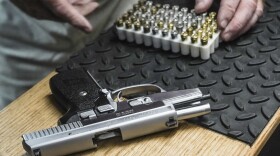At anti-racism rallies and marches across the country, protesters are coming face to face with police — but also with heavily armed civilians. America’s gun laws make it difficult to diffuse the tension.
Armed counterprotesters, mostly white and some members of the militia movement, have confronted anti-racism rallies in at least 33 states, according to a review of reporting and social media by Guns & America.Some say they’re there to protect businesses. Others oppose the Black Lives Matter movement. Some have acted like police, stopping protesters and demanding identification.
And it has led to violence. In Albuquerque, New Mexico a . In Oregon, for allegedly pointing a gun at protesters. In Ohio, local government officials said gun rights advocates were .
An 18-year-old man was arrested in June after firing a shot into the ground during a Boise protest, panicking the crowd. The next day in Boise, at a vigil for Black Americans killed by police and vigilantes, a white man with a semi-automatic rifle stood up in the middle of a crowd of thousands, yelling to interrupt a speaker. He walked away after a vigil supporter stood between him and the stage, but it was a tense moment.
One of the organizers of the vigil, Whitney Mestelle, said she and her team have plans in place for security at these events, but she won’t be intimidated.
“I think security for black people is always a concern, especially when we group together,” she said. “But it’s something for the vigil that I really, really, really impressed upon our volunteers and the other people that joined us in helping that: It’s not something we’re going to give our time, our attention to [counterprotesters].”

Thousands attend a vigil for Black Americans killed by police and vigilantes in Boise, Idaho, on June 2. In the midst of the peaceful gathering a white man with a rifle stood up in the middle of the crowd and started yelling.
Heath Druzin / Boise State Public Radio
The First Vs. Second Amendment
Armed protesters and vigilantes are able to operate freely in much of the country. That’s because many states have increasingly relaxed gun laws, leaving law enforcement unable or unwilling to step in, even when protesters say they are being intimidated.
That’s a problem, said Shaakirrah Sanders, a law professor at the University of Idaho: “To put it bluntly, white men with guns have been very scary throughout American history if you’re a person of color.”
Yes, Sanders says, broad interpretations of the Second Amendment mean there is a lot of freedom to walk around armed in many places. But she wants officers to take initiative and head off the armed people she sees as clearly threatening protesters.
“If I’m the only person of color, or one of the few persons of color in my community,” she said, “how can I really effectively exercise my First Amendment rights if I know they’re going to be armed individuals there who suspect me for some reason?”
In a state like Idaho there’s very little left in the law to regulate what you can do with a gun. As in many conservative states, Idaho lawmakers have spent the last few years stripping away many of the few gun restrictions that remained. Just , for instance, prohibit people from openly carrying handguns, according to the Giffords Law Center, the research arm of a gun control group. Just 12 states place restrictions on carrying long guns, like semi-automatic rifles.
Even Ben Wolfinger, the gun-friendly sheriff of North Idaho’s Kootenai County, admitted lax gun laws can put officers in awkward positions. The county’s biggest town, Coeur d’Alene has seen , supposedly to defend businesses.
But Wolfinger said officers’ hands were tied when the gunmen started getting drunk at downtown bars while handling their rifles.
“There really isn’t anything — I mean, we can certainly recommend that, you know, that they don’t be drinking while they’re armed,” he said. “But that’s the best thing we can do.”
Problems For Protesters And Police
Many of these armed, self-appointed security guards say they’re defending against antifa, a left-wing movement that .
Gary Raney, who spent a decade as a sheriff in Idaho, doesn’t buy it.
“When there is looting going on in metropolitan cities, that somebody is going to protect their shop, I totally get that,” he said. “But showing up at a place just to intimidate peaceful protesters, which has happened, and has happened in Idaho, there’s no room for that.”
Raney now acts as a law enforcement consultant for the U.S. Department of Justice and trains law enforcement around the country in use-of-force protocols. He says a steady rollback in any gun regulations has also put law enforcement in danger.
“I mean, now we have armed groups who are looking for the opportunity to create insurrection in government and do some sort of overthrow,” said Raney. “So as an officer responding, you don’t know who you’re dealing with — you suddenly have 10, 20, 30 armed people out there.”
And Sanders, the University of Idaho law professor, wants police to understand that the mere presence of armed white people at a rally can be a threat to people of color.
“How much of that context are we supposed to be tolerant of, especially now where you’ve had recent murders of young black men, particularly of Ahmaud Arbery, Trayvon Martin, where [the shooters] are supposedly afraid for their lives,” she said.
With , according to industry estimates, these conflicts are likely to continue.
Guns & America’s Lisa Dunn, Francesca Slesinger and Jeremy Bernfeld contributed to this story.
is a public media reporting project on the role of guns in American life.
Copyright 2021 Guns and America. To see more, visit . 9(MDAxNzg0MDExMDEyMTYyMjc1MDE3NGVmMw004))








